| previous - contents - next |
In this chapter, you will learn about the main screen of the SuperMemo application, the database list. You can see an example database list screen on the right. The actual screen on your device may look quite different, especially when you have no databases yet. This chapter will discuss the following topics: |
 |
|
The first column in the list of databases shows database icons. Each database has one of the two possible icons. Little asterisk icon you can see on the first line for instance, denotes a database that has not been committed. It means that no card of the database has been committed yet, and the database is not a part of the learning process. SuperMemo algorithms do not care about this database. Such database will never have tests, as there are no committed cards, hence nothing to test; however, it can have a drill, because unlike tests, you can create your own drills if you want to. Drills have no effect on SuperMemo learning algorithms. The second icon type are the two rectangles, symbolizing a pack of cards as you can see on the second line for instance. This icon denotes a committed database. At least one card of the database has been committed to the SuperMemo learning algorithms. Such database will have both tests and drills. The plus icon in the lower left corner of the database list screen can be considered an icon of all databases grouped together. |
|
The second column in the list of databases shows database names. Each name is printed either in standard or bold font face. Database name printed in bold face indicates that you need to work on the database today. It has at least one card in the test or drill. Once you finish both the test and the drill, the name will be displayed in standard font. Database name printed in standard (non-bold) face indicates a database that has no test and no drill. You do not need to work with the database today. The same applies to the last Total line. If there is at least one test or drill in any database, the Total label is printed in bold face. If there are no tests and no drills in all databases, your work is over and the Total label is shown in standard font. If the database name is too long to fit the column, the name is shortened and an ellipsis (3 dots character) is appended to end of the truncated name. |
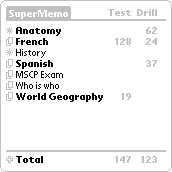 |
|
The third column in the list of databases shows you the available tests. If any database has a test, you will see a number in the line showing you the count of the cards in the test. If there is no test prepared for a database, there will be no entry (not even a zero) in the test column. The last Total line shows a total number of cards in all tests. If there are no available tests at all, the whole test list column including the sum and header will be hidden. |
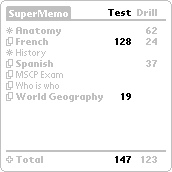 |
|
The third column in the list of databases shows you the available drills. If any database has a drill, you will see a number in the line showing you the count of the cards in the drill. If there is no drill prepared for a database, there will be no entry (not even a zero) in the drill column. The last Total line shows a total number of cards in all drills. If there are no available drills at all, the whole drill list column including the sum and header will be hidden. |
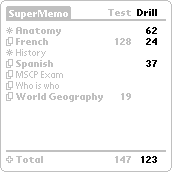 |
|
If you have more than 11 databases, they will not fit the screen all at once. In such case, a scroll bar will appear on the right and you can use it to scroll the list up or down. Drag the scroll bar car (the narrow black rectangle) to move the list to the desired position. You can also tap the dotted areas above or below the car to move the list one page up or down, or you can tap the little arrows at the ends of the scroll bar to move the list one line up or down. You can also use the hardware Up and Down buttons to scroll the database list one page up or down. |
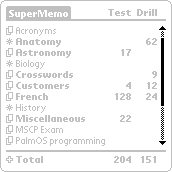 |
|
If you want to learn some details about a particular database, just tap its icon. This will open the Database Details screen with information about the selected database. In this screen you can also perform some database operations such as renaming, resetting or deleting the database. For information about meanings of the Database Details screen values and about database operations available in this screen, see the Database Details chapter. |
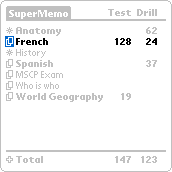 |
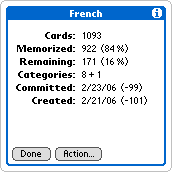 |
|||||
If you want to learn some details about all databases grouped together, you can tap the plus icon in the last Total line. This will open the All Databases screen with aggregated information about all databases. In this screen you can also create a new database. Note that if you do not have any SuperMemo database yet, the Total label in the last line of database list screen will be replaced with a New Database hint. For information about meanings of aggregate database values and about creating new databases see the Database Details chapter. |
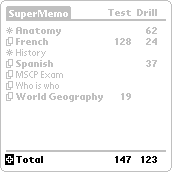 |
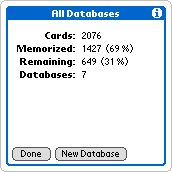 |
|
To open a particular database, just tap its name. This will open the database in the list view and you can start viewing, editing or creating cards. For information about working with databases, see the Card List chapter. |
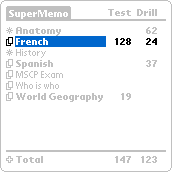 |
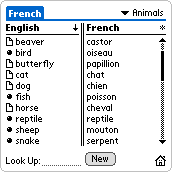 |
|
If you want to start your daily test, just tap the number that shows how many cards are in the test. This will open the test and you can immediately start working on it. For information about working with tests, see the Tests chapter. |
 |
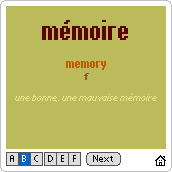 |
|
If you want to start a drill, just tap the number that shows how many cards are in the drill. This will open the drill and you can immediately start working on it. You can drill items in normal (e.g. English to French) or reversed mode (e.g. French to English). For information about working with drills, see the Drills chapter. |
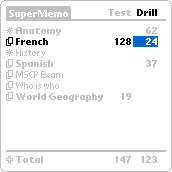 |
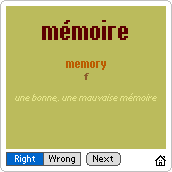 |
|
|
© MapleTop Software |
|
|